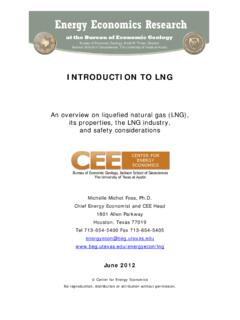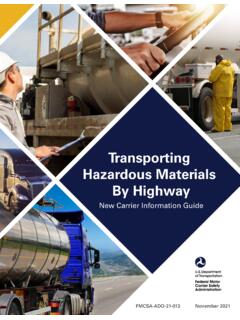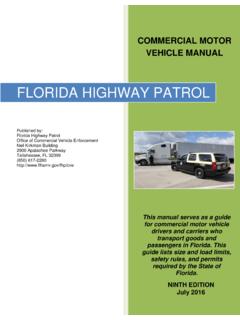Transcription of INTERSTATE NATURAL GAS—QUALITY SPECIFICATIONS ...
1 Center for Energy Economics. No reproduction, distribution or attribution without permission. INTERSTATE NATURAL GAS QUALITY SPECIFICATIONS & INTERCHANGEABILITY Michelle Michot Foss, Chief Energy Economist and CEE Head 1650 Highway 6, Suite 300 Sugar Land, Texas 77478 Tel 281-313-9763 Fax 281-340-3482 December 2004 2 INTERSTATE NATURAL GAS QUALITY SPECIFICATIONS & INTERCHANGEABILITY1 I) INTRODUCTION & BACKGROUND The INTERSTATE NATURAL gas industry in the United States is nearing a crossroads.
2 Driven by ever increasing demand, a diverse new supply mix is emerging. The gas quality characteristics defining this supply portfolio, most notably those characteristics associated with liquefied NATURAL gas (LNG) and richer, casinghead gas, along with fundamental changes in the economics of traditional gas processing embedded in the value of NATURAL gas vs. NATURAL gas liquids (NGLs), underpin the need to reexamine historic business practices, regulations and tariffs. This paper will address these issues, examining the historic evolution of NATURAL gas quality standards in INTERSTATE commerce, analyze current standards and practices built into operational tariffs, address changing supply patterns gas and their impact on merchantability and fungibility of NATURAL gas and evaluate the practical and financial impacts to suppliers, INTERSTATE NATURAL gas pipelines, local distribution companies (LDC s) and end users.
3 Finally, it will attempt to put forth viable and practical recommendations to address the concerns and risks posed and hopefully insure a robust and vital continuing NATURAL gas industry in the United States. II) OVERVIEW The United States demand for NATURAL gas stood at Tcf for 2002 and is expected to continue to rise to approximately Tcf by 2025 according to the Energy Information Association (EIA)2 and others. This demand growth pattern emerged through the 1980 s and beyond as a reaction to a variety of drivers, most notably robust GDP increases, general environmental consciousness and increased usage in electric power generation.
4 1 This publication was undertaken by the Center for Energy Economics (CEE) as the Institute for Energy, Law & Enterprise, University of Houston Law Center The paper was prepared by Mr. Joseph Wardzinski, Senior Associate, Dr. Michelle Michot Foss, Executive Director and Mr. Fisoye Delano, Senior Researcher, UH IELE. The views expressed in this paper are those of the authors. 2 EIA, Annual Energy Outlook 2004, 3A new NATURAL gas supply portfolio is emerging to meet this demand growth.
5 Traditional domestic onshore and Gulf of Mexico (GOM) shelf production is waning. The relative economics of exploring for and producing NATURAL gas has resulted in continued activity in the deepwater Gulf of Mexico and ever increasing development activity for liquefied NATURAL gas (LNG) to be delivered to new domestic U. S. terminals sourced from stranded gas locations throughout the world. Longer term, in all likelihood, Arctic supplies and production from frontier areas in Canada will alter this supply portfolio as well.
6 The NATURAL gas quality characteristics associated with this new supply mix are and will be different from traditional domestic supply sources and will impact economic and operational practices on the INTERSTATE NATURAL gas grid and may permanently alter business methodologies and regulatory tariffs. The changing supply portfolio and relative economic conditions of the NATURAL gas and NATURAL gas liquids (NGL s) markets pose interchangeability / fungibility and NATURAL gas quality issues impacting merchantability, operational and safety concerns.
7 These issues, for the most part, are not adequately addressed by current INTERSTATE NATURAL gas pipeline tariffs as a whole. These NATURAL gas quality issues can be broadly categorized into two general areas of concern, which are related, but which nonetheless are separate and distinct. (i) Domestic, unprocessed, rich, higher heating value (HHV) production entering INTERSTATE commerce-- ( NATURAL Gas Quality Hydrocarbon Liquids & Dew Point Control ). Traditionally, domestic production has been processed after gathering and treating to remove, or strip, heavier, rich and valuable hydrocarbons such as ethane, butane, propane et al from the raw gas stream prior to introduction into INTERSTATE commerce.
8 Processing served two vital roles, first it allowed an operationally safe, largely consistent quality and commercially fungible NATURAL gas product to enter INTERSTATE commerce and secondly allowed a profitable petrochemical feedstock business for NGL s to emerge. Today, the economic reality of gas processing has been largely inverted due to relative value changes in the NATURAL gas and NGL markets, resulting in so called upside down economics . That is, with commercial transactions being conducted on a thermal equivalency basis, dekatherms (dt s) remaining in the residue gas stream are more valuable than potential NGL s, and 4therefore processing plants are not running.
9 How long these economic conditions will persist, no one can accurately predict. There is a chemical property phenomenon of many substances to change phase under varying temperature and pressure conditions. The dew point refers to the temperature at which a substance will condense from its gaseous or vapor phase into a liquid. The richer, ( heavier or larger molecular mass) hydrocarbon components which may be entrained in the composite gas stream in the absence of gas processing tend to possess dew points that predispose them to condense and fallout at favorable lower temperatures which may prevail downstream on the pipeline.
10 The frequency and magnitude of this issue may be further exacerbated by the ever increasing production of rich, casing head gas entering the INTERSTATE system from deepwater Gulf of Mexico developments, which in all likelihood will continue. The end result is ever increasing concern over heavier hydrocarbons and inert gases entering INTERSTATE commerce and the associated operational, system integrity and safety problems this situation poses. In particular this is highlighted by the potential for hydrocarbon liquid fallout at varying temperature and pressure conditions as the NATURAL gas stream traverses the grid and the potential impact on pipeline operations and end users.







